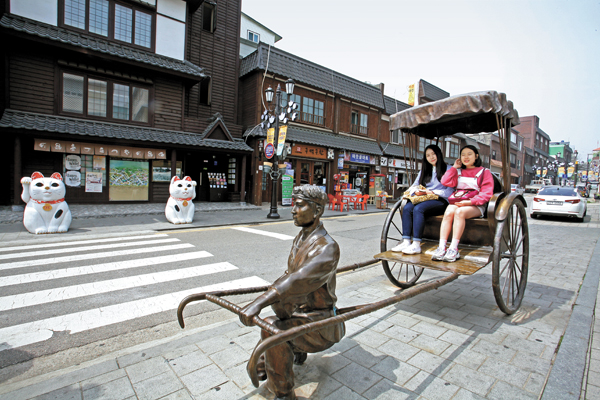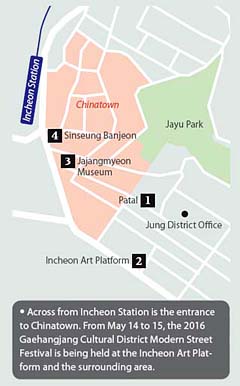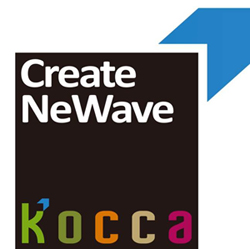Go back in time in Incheon Gaehangjang

In the area near Incheon Harbor, which is also called Incheon Gaehangjang, visitors can enjoy old-time Japanese and Chinese culture. [LIM HYUN-DONG]
With the influx of products and people from across the world to the area called Incheon Gaehangjang, the once-quiet seaside village became exotic, and many locals began to head to Incheon to get a glimpse of what was happening outside Korea. Foreigner residential districts were set up, and foreign banks and trade companies opened in the area. Shops selling products from overseas began to crowd the streets. Many of the first Western-style buildings and venues in Korea opened in the area, such as the first Western-style hotel, the Daebul Hotel, which opened in 1888; the first Western-style public park, now called Jayu Park, in 1891; and a foreigners’ social club in 1891.
With many historic buildings and artifacts still scattered around the area, the Korea Creative Content Agency has been working to develop events that can bring in more people who want to learn more about what Korea was like 100 years ago, and how the history of the harbor contributed to present-day Incheon.

While building on the popularity of Chinatown, the festival plans to show visitors that there is much more to see and enjoy in the area. The festival is taking place at the Incheon Art Platform, an area filled with historic buildings which were originally built between 1930 and 1940. The 13 red brick structures are now used as work and living spaces for artists, performance theaters, archives and exhibition halls.
One of the major events at the festival is a media facade supported by the Korea Creative Content Agency and the Ministry of Culture, Sports and Tourism. The walls of the Samu Printing Shop (built in 1902) and the Geummacha Cafe (built in 1943) will be used to show videos that include stories that once happened in the area. The media facade show will run twice a day at 8 p.m. and 9:20 p.m.
There will also be a cultural market called “Suremarket” and a food zone called “Mangukyasijang” at the festivals. In addition, visitors can try on different styles of traditional clothing during the festival to experience the lifestyle of the early 1900s.
To help visitors learn more about the modern Korean history imbued in the buildings of the area, Incheon’s Jung District Office is running free guided walking tours. For more information about the tour programs, call (032) 773-7511. Due to high demand, booking in advance is recommended.
After taking a look at the interesting architecture, visitors may not be able to resist the tempting smells coming from restaurants in the area that have been in operation for decades. The area has many Chinese and Japanese restaurants passed down or inspired by those who came to Korea in the 1880s. Between the Jung District Office and Chinatown, one will encounter the steps leading to Jayu Park, where one can find a statue of Confucius. On the left is Chinatown and on the right are many remnants of Japanese and Russian culture.
In Chinatown, Gonghwachun, which was built in 1908 as one of the first Chinese restaurants in Korea, has been renovated into the Jajangmyeon Museum. Jajangmyeon is one of the localized Chinese dishes that features noodles with black soybean sauce and stir-fried vegetables, and the granddaughter of Gonghwachun’s founder still serves the original recipe at her restaurant, Sinseung Banjeom, located nearby. The restaurant is one of the must-visit spots for lovers of jajangmyeon, and one bowl costs 5,000 won ($4.28). Other dishes such as sweet-and-sour pork (18,000 won) are also popular there.
If you’re more in the mood for a snack, there are many Chinese-inspired street foods available in the area. Two of the most popular spots are Bokraechun and Siblihang. Bokraechun sells gonggalbbang (crispy, hollow pastries) for 3,000 won and wolbyeong (mooncake, a traditional Chinese cookie) for 5,000 won. Siblihang offers grilled mandu, or dumplings, for 2,000 won.
While Chinatown is located along the hillside and filled with hustle and bustle, the Japanese neighborhood is rather quiet and more relaxing. In the area, two- and three-story wooden buildings line the streets.
One of the over-100-year-old wooden structures, built in 1885 as an office and residence for employees of a trading company, has been turned into a cafe called Patal. It is one of the rare buildings that maintains not only the original facade but also the old-style interior. Inside the cafe is a small garden. The most popular item on the menu is patbingsu, or shaved iced with red bean, which is 7,000 won.
Cafe Bingo is place worth visiting in the area. It is located in an alleyway between the Incheon Art Platform and Shinpo International Market. Architect Lee Ui-jung renovated what was an ice storage facility built in the 1920s into a cafe. Visitors can still see remnants of the original structure, such as the thick walls and narrow doors that kept the cold air in. At this cafe, there is only one big communal table so that even strangers can sit and talk to one another over a cup of coffee, which costs around 4,000 won.

1. The cafe Patal maintains the characteristics of an old Japanese-style wooden building. 2. A media facade show is projected onto the wall of a historic building at the Incheon Art Platform. 3. The Jajangmyeon Museum is located in Chinatown. 4. Sinseung Banjeom serves up sweet-and-sour pork and jajangmyeon.











with the Korea JoongAng Daily
To write comments, please log in to one of the accounts.
Standards Board Policy (0/250자)